USS Wisconsin
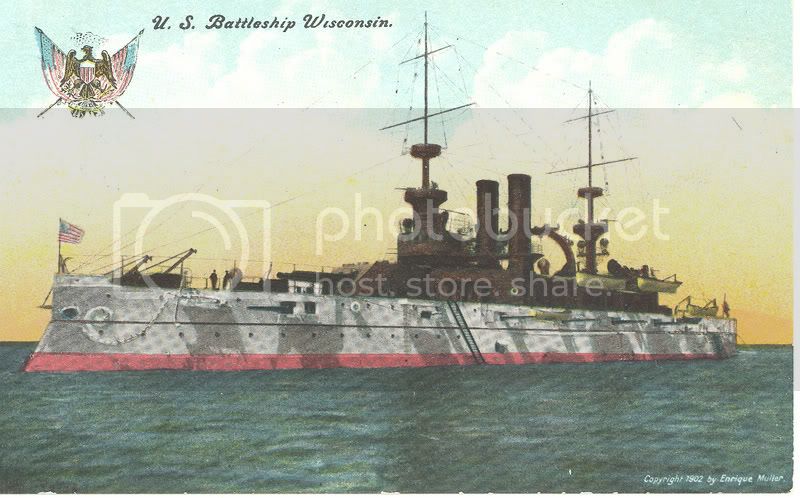
General Statistics
Displacement: 12,150 tons fully laden
Length: 374 feet
Beam: 72 feet
Draft: 25 feet
Speed: 16 knots
Complement: 817 officers and men
Armament: 4 x 13 inch guns
14 x 6 inch guns
16 x 6 pounder guns
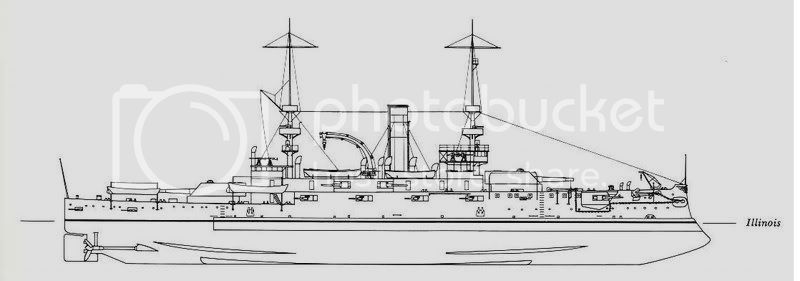
USS Wisconsin (BB-9), an Illinois-class battleship, was the first ship of the United States Navy to be named for the thirtieth state.
Her keel was laid down on the 9th of February 1897 at San Francisco, California, by the Union Iron Works. She was launched on the 26th of November 1898 sponsored by Miss Elizabeth Stephenson, the daughter of Senator Isaac Stephenson of Marinette, Wisconsin, and commissioned on the 4th of February 1901 with Captain George C. Reiter in command.
Departing San Francisco on the 12th of March 1901, Wisconsin conducted general drills and exercises at Magdalena Bay, Mexico, from the 17th of March to the 11th of April before she returned to San Francisco on the15th of April to be drydocked for repairs. Upon completion of that work, Wisconsin headed north along the Western seaboard, departing San Francisco on the 28th of May and reaching Port Orchard, Washington, on the1st of June. She remained there for nine days before heading back toward San Francisco.
A picture of the USS Wisconsin in San Francisco Bay, California, dressed with flags and with her crew manning the rail in honor of the Presidential party, 1901.
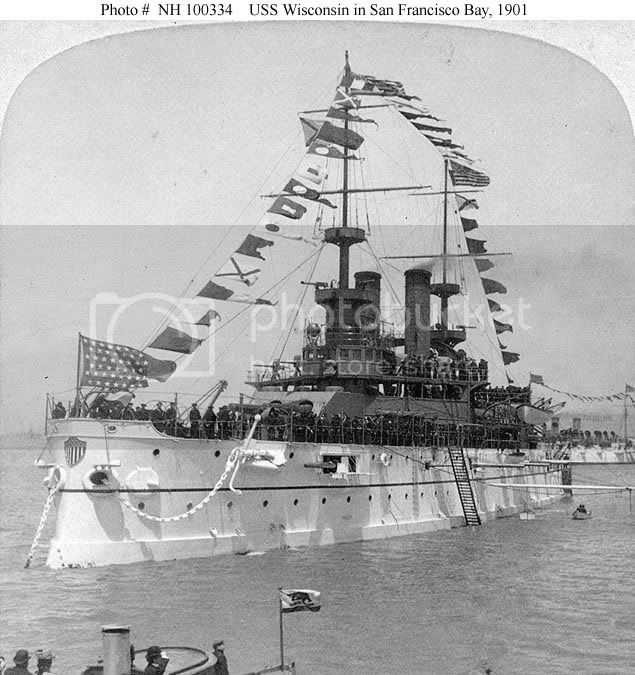
The USS Wisconsin off San Francisco, California, in 1901
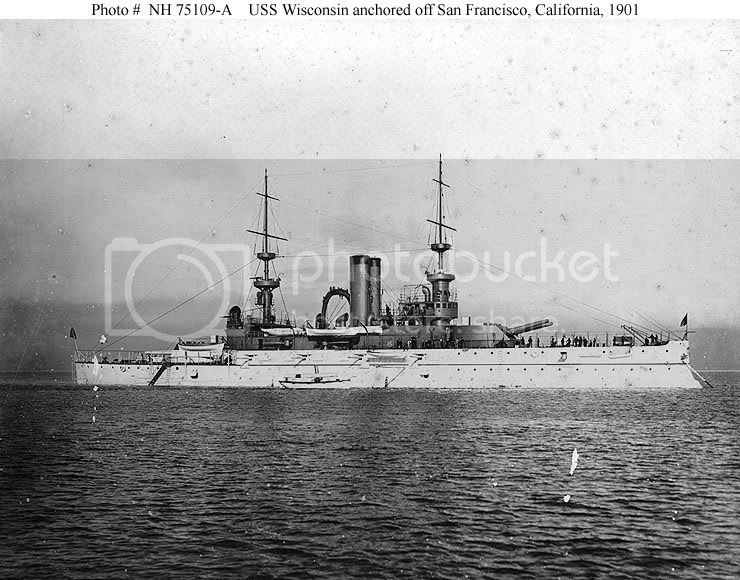
She next made a voyage in company with the battleships Oregon and Iowa, the cruiser Philadelphia, and the torpedo-boat destroyer Farragut to the Pacific Northwest, reaching Port Angeles, Washington, on the 29th of June. She then shifted to Port Whatcom, Washington, on the 2nd of July, and participated in the 4th of July observances there before she returned to Port Angeles the following day to resume her scheduled. drills and exercises. Those evolutions kept the ship occupied through mid-July.
Following repairs and alterations at the Puget Sound Navy Yard in Bremerton, Washington, from the 23rd of July to the 14th of October, Wisconsin sailed for the middle and southern reaches of the Pacific, reaching Honolulu, Hawaii, on the 23rd of October. After coaling there, the battleship then got underway for Samoa on the 26th of October and exercised her main and secondary batteries en route to her destination.
Reaching the naval station at Tutuila on the 5th of November, Wisconsin remained in that vicinity, along with the collier Abarenda and the hospital ship Solace, for a little over two weeks. Shifting to Apia, the scene of the disastrous hurricane of 1888, Wisconsin hosted the Governor of German Samoa before the man-of-war departed that port on the 21st of November, bound for the coastal waters of Central and South America via Hawaii.
Wisconsin reached Acapulco, Mexico, on Christmas Day, 1901, and remained in port for three days. After coaling, the man-of-war twice visited Callao, Peru, and also called at Valparaíso, Chile, before she returned to Acapulco on the 26th of February 1902.

Wisconsin exercised in Mexican waters at Pichilinque Bay and Magdalena Bay from the 6th of March to the 22nd of March, carrying out an intensive and varied slate of exercises that included small-arms drills, day and night main battery target practices, and landing force maneuvers. She conducted further drills of various kinds as she proceeded up the West Coast, touching at Coronado, California, San Francisco, and Port Angeles before she reached the Puget Sound Navy Yard on the 4th of June.
The battleship underwent repairs and alterations until the 11th of August. She then conducted gunnery exercises off Tacoma, Washington, and Seattle, Washington, before she returned to the Puget Sound Navy Yard on the 29th of August for further work. She remained there until the12th of September, when she sailed for San Francisco, en route to Panama.
USS Wisconsin, as flagship, Pacific Squadron, with Rear Admiral Silas Casey on board, arrived at Panama, Colombia, on the 30th of September 1902, to protect American interests and to preserve the integrity of transit across the isthmus. Casey offered his services as a mediator in the crisis that had lasted for three years and invited leaders of both factions, conservatives and liberals, to meet on board Wisconsin. Over succeeding weeks, through October, and into November, prolonged negotiations ensued. Ultimately, however, the warring sides came to an agreement, and signed a treaty on the 21st of November 1902. The accord came to be honored, in Colombian circles, as "The Peace of Wisconsin." When Rear Admiral Henry Glass, Admiral Casey's successor as Commander in Chief, Pacific Squadron, wrote his report to the Secretary of the Navy for fiscal year 1903, he lauded his predecessor's diplomatic services during the Panama crisis. "The final settlement of the revolutionary disturbance," Glass wrote approvingly, "was largely due to his efforts."
Her task completed, the battleship departed Panama's waters on the 22nd of November and arrived at San Francisco on the 6th of December to prepare for gunnery exercises. Four days later, Rear Admiral Casey shifted his flag to the armored cruiser New York, thus releasing Wisconsin from flagship duty for the Pacific Squadron. The battleship consequently carried out her firings until the17th of December, when she sailed for Bremerton. reaching the Puget Sound Navy Yard five days before Christmas of 1902, Wisconsin then underwent repairs and alterations until the19th of May 1903, when she sailed for the Asiatic Station.
Proceeding via Honolulu, Wisconsin arrived at Yokohama, Japan, on the12th of June, with Rear Admiral Yates Stirling on board; three days later, Rear Admiral Stirling exchanged flagships with Rear Admiral P. H. Cooper who broke his two-starred flag at Wisconsin's main as Commander of the Asiatic Fleet's Northern Squadron while Admiral Stirling hoisted his in the tender Rainbow.
Wisconsin operated in the Far East, with the Asiatic Fleet, over the next three years before she returned to the United States in the autumn of 1906. She followed a normal routine of operations in the northern latitudes of the station -- China and Japan -- in the summer months, because of the oppressive heat of the Philippine Islands that time of year, but in the Philippine Archipelago in the winter. She touched at ports in Japan and China including Kobe, Yokohama, Nagasaki, and Yokosuka; Amoy, Shanghai, Chefoo, Nanking, and Taku. In addition, she cruised the Yangtze River as far as Nanking, the Inland Sea, and Nimrod Sound. The battleship conducted assigned fleet maneuvers and exercises off the Chinese and Philippine coasts intervening those evolutions with regular periods of in-port upkeep and repairs. During that time, she served as Asiatic Fleet flagship, wearing the flag of Rear Admiral Cooper.
The battleship departed Yokohama on the 20th of September and, after calling at Honolulu en route between the 3rd of October and the 8th of October, arrived at San Francisco on the18th of October. After seven days stay at that port, she headed up the West Coast and reached the Puget Sound Navy Yard on the 28th of October. She was decommissioned there on the 16th of November 1906.
She was recommissioned on the 1st of April 1908, Captain Henry Morrell in command, Wisconsin was fitted out at the Puget Sound Navy Yard until the end of April. After shifting to Port Angeles from the 30th of April to the 2nd of May, the battleship proceeded down the western seaboard and reached San Francisco on the 6th of May to participate in a fleet review at that port. She subsequently returned to Puget Sound to complete the installation of her fire control equipment between the 21st of May and the 22nd of June.
Soon thereafter, Wisconsin retraced her southward course, returning to San Francisco in early July. There, she joined the battleships of the Atlantic Fleet in setting out on the transpacific leg of the "Great White Fleet".
The USS Wisconsin departed from the Tidewater area on the 6th of March and arrived at the Portsmouth Navy Yard in New Hampshire three days later. The pre-dreadnought battleship underwent repairs and alterations until the 23rd of June, doffing her bright "white and spar color" and donning a more businesslike gray. The man-of-war joined the Atlantic Fleet in Hampton Roads at the end of June, but she remained in those waters only a short time before she sailed north to Portland, Maine, arriving there on the 2nd of July in time to take part in the Fourth of July festivities in that port.
The USS Wisconsin under refit at the Portsmouth Navy Yard, Kittery, Maine, circa April-May 1909. She was then in the process of having her "military" foremast replaced with one of the "basket" type.
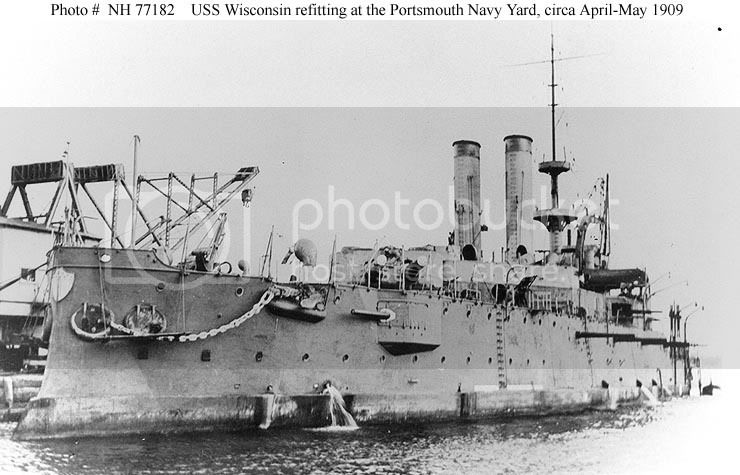
At the Portsmouth Navy Yard, Kittery, Maine, on the 29th of June 1909, after being fitted with a "basket" foremast
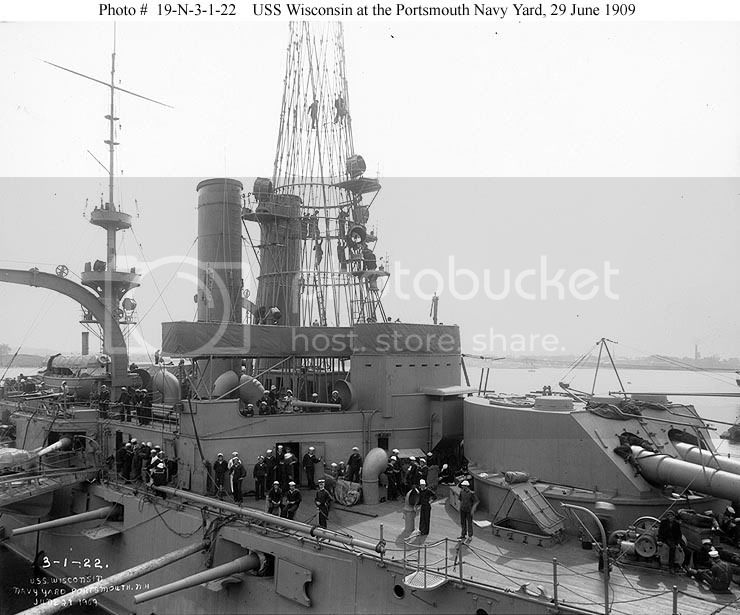
The USS Wisconsin underway, circa 1909-1910, after being refitted with a "cage" foremast.
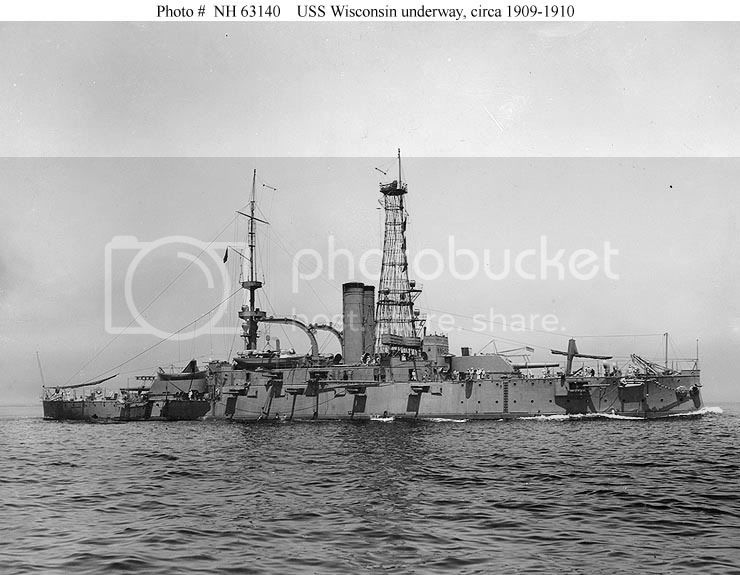
The battleship next headed down the eastern seaboard, cruising off Rockport, Massachusetts, and Provincetown, Massachusetts, before she returned, with the Fleet, to Hampton Roads on the 6th of August. Over the ensuing weeks, Wisconsin fired target practices in the southern drill grounds, off the Virginia capes, breaking those underway periods with upkeep in Hampton Roads.
Wisconsin steamed with the fleet to New York City where she anchored in the North River to take part the Hudson-Fulton celebrations between the 22nd September and the 5th October before she underwent repairs at the Portsmouth Navy Yard from the 7th of October to the 28th of November. She then dropped down to Newport, Rhode Island, upon the conclusion of that yard period, picking up drafts of men for transportation to the Atlantic Fleet at Hampton Roads.
Wisconsin operated with the fleet off the Virginia capes through mid-December, before she headed for New York for the Christmas holidays in port. Subsequently cruising to Cuban waters in early January 1910, the battleship operated out of Guantanamo Bay for a little over two months, from the 12th of January to the19th of March.
The pre-dreadnought battleship then visited Tompkinsville, New York, and New Orleans, Louisiana, before she discharged ammunition at New York City on the 22nd of April. Later that spring, 1910, she moved to the Portsmouth Navy Yard, where she was placed in reserve. She was moved to Philadelphia, Pennsylvania, in April 1912 and, that autumn, took part in a naval review off Yonkers, New York, before resuming her reserve status until Atlantic Reserve Fleet. Placed "in ordinary" on October 1913, Wisconsin remained in that status until she joined the United States Naval Academy Practice Squadron the spring of 1915 assuming training duties along with the battleships Missouri and Ohio. With that group, she become the third battleship to transit the Panama Canal, making that trip in mid-July 1915 en route to the west coast of the United States with her embarked officers-to-be.
Wisconsin discharged her duties as a midshipman's training ship into 1917 and was moored at the Philadelphia Navy Yard on the 6th of April of that year when she received word that the United States had declared war on Germany. Two days later, members of the Naval Militia began reporting on board the battleship for quarters and subsistence.
On the 23rd of April, Wisconsin, Missouri, and Ohio were placed in full commission and assigned to the Coast Battleship Patrol Squadron. Within two weeks, on the 2nd of May, Commander (later Admiral) David F. Sellers reported on board and took command. Four days later, the battleship got underway for the Virginia capes; and she arrived at Yorktown, Virginia, on the 7th of May. From early May through early August, Wisconsin operated as an engineering school ship on training cruises in the Chesapeake Bay-York River area. She trained recruits as oilers, watertenders, and firemen, who, when qualified, were assigned to the formerly interned merchantmen of the enemy taken over by the United States upon the declaration of war, as well as to submarine chasers and the merchant vessels then building in American yards.
Wisconsin then maneuvered and exercised in company with the battleships Kearsarge, Alabama, Illinois, Kentucky, Ohio, Missouri, and Maine, between the 13th August and 19th of August, en route to Port Jefferson, New York. Over the ensuing weeks, Wisconsin continued training and tactical maneuvers based on Port Jefferson, making various training cruises into Long Island Sound.
She subsequently returned to the York River region early in October and resumed her training activities in that locale, operating primarily in the Chesapeake Bay area. Wisconsin continued that duty into the spring of 1918, interrupting her training evolutions between the 30th of October and the 18th of December 1917 for repairs at the Philadelphia Navy Yard.
After another stint of repairs at Philadelphia from the 13th of May to the 3rd of June 1918, Wisconsin got underway for a cruise to Annapolis, Maryland, but, after passing the Brandywine Shoal Light, received orders to stick close to shore. Those orders were later modified to send Wisconsin up the Delaware River as far as Bombay Hook, since an enemy submarine was active off Cape Henlopen. Postwar examination of German records would show that U-151, the first of six enemy submarines to come to the eastern seaboard in 1918, sank three schooners on the 23rd of May and other ships over ensuing days.
Getting underway again on the 6th June, Wisconsin arrived at Annapolis on the following day. On the next day, the battleship embarked 176 third-class midshipmen and got underway for the York River. The ship conducted training evolutions in the Chesapeake Bay region until the 29th of August, when she returned to Annapolis and disembarked midshipmen. Underway for Yorktown on the 30th of August, Wisconsin there embarked 217 men for training as firemen, water tenders, engineers, steersmen and signalmen, resumed her training duties, and continued the task through the signing of the armistice on the 11th of November.
She completed her training activities on 20th of December, sailed north, and reached New York City three days before Christmas. Wisconsin was among the ships reviewed by Secretary of the Navy Josephus Daniels from the deck of the yacht Mayflower and by Assistant Secretary of the Navy Franklin D. Roosevelt from Aztec on the day after Christmas, 26th December.
Wisconsin cruised with the fleet in Cuban waters that winter and, in the summer of 1919, made a midshipman training cruise to the Caribbean.
Placed out of commission on the 15th of May 1920, Wisconsin was reclassified BB-9 on 17th of July 1920, while awaiting disposition. She was sold for scrap on the 26th of January 1922.
Regards
Sean









